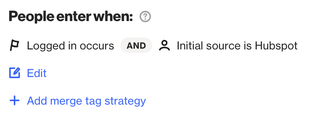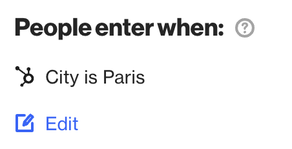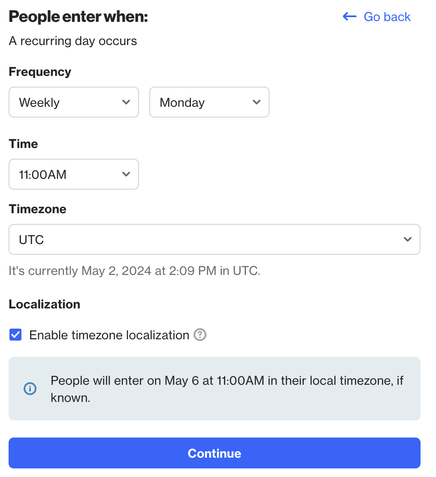Using "occurs" in campaign entry criteria
Overview
This page explains the difference between entry criteria with and without the occurs condition. It also covers what happens when a campaign is turned on / off, or when entry criteria is modified.
While this page touches on how a person might re-enter a campaign, more detailed guidance on intentionally re-entering contacts into a journey or playbook can be found in our how to re-enter people into a journey or playbook campaign article.
Entry criteria with an “occurs” condition
In a journey or playbook with an occurs condition in the entry criteria, people will only enter when the specified activity occurs. You can also narrow down who enters by adding additional criteria with an AND condition.
EX: New trial occurs AND Referral is Google.

NOTE: When you perform a backfill of activities for connected data sources, activities older than 6 hours will not quality for occurs conditions.
Switching the campaign ON for the first time
- Switching the campaign ON for the first time will cause people to enter the journey/playbook only when the activity occurs in the future.
- The person can then re-enter the campaign when they perform the specified activity again.
NOTE: For journeys, the People can be in journey setting must be configured to allow people to enter the journey multiple times. Otherwise, they will enter only once when the activity first occurs.
Modifying the entry criteria while the campaign is switched ON
If the entry criteria is modified while the campaign is switched ON:
- People will only enter the campaign when the specified event occurs in the future.
- If you remove the occurs activity condition, the behavior will be as described in the Entry criteria without an “occurs” condition section below.
- People who are already in the campaign (they met the old entry criteria) will continue through the journey/playbook until they meet the exit criteria.
Switching the campaign OFF
Switching the campaign OFF will stop new people from entering the campaign.
Regarding people who were in the campaign when it was switched OFF:
- For Journeys:
- People already in the campaign will be temporarily held in the shape they are currently in until the journey is switched back ON, after which they will resume their journey.
- People will be held at that shape for as long as the exit criteria setting They don’t move for X days allows.
- For Playbooks:
- People already in the campaign will temporarily remain in the playbook until it is switched back ON, after which they will resume receiving the remaining messages.
- People will be held in the playbook for as long as the exit criteria setting (No new messages are sent for X days) allows.
Switching the campaign back ON
When the campaign is switched back ON (after being switched OFF), people enter the journey/playbook only when the specified event occurs.
This means that:
- For Journeys:
- New people who meet the criteria will enter.
- For people who meet the criteria and have previously entered the journey, their re-entry to the journey will be determined by the People can be in journey setting.
- For Playbooks:
- New people who meet the criteria will enter.
- People who meet the criteria and have previously entered the playbook will re-enter.
NOTE:
- If you remove the Set a last entry date filter after the date has passed (while the campaign is ON), the entry criteria will be re-evaluated as if the journey/playbook was turned OFF and back ON again.
- People already in the journey will be paused at their current shape. It may take up to 5 minutes for these people to be processed and continue once the journey is back ON.
Entry criteria without an “occurs” condition
When a campaign has entry criteria without an occurs condition (such as tags, field values, or has/has not occurred conditions), people will enter the journey the first time they meet the criteria.

Modifying the entry criteria or switching a journey ON/OFF will affect entry differently, as follows.
Switching the campaign ON for the first time
Switching the campaign ON will cause people to enter the campaign immediately if they already meet the criteria, or they will enter the first time they meet the entry criteria in the future.
Modifying the entry criteria while the campaign is switched ON
If the entry criteria is modified while the campaign is switched ON:
- New people who meet the updated condition will enter the campaign.
- People who are already in the campaign will continue until they meet the exit criteria.
- People who still meet the old entry criteria will not re-enter the campaign.
- People who no longer meet the old entry criteria, but do meet the new entry criteria, will enter (for journeys, this depends on whether the journey allows multiple entries).
Example to illustrate the last two points above:
Your campaign entry criteria is New trial has occurred in the last 14 days. You update it to: New trial has occurred in the last 14 days OR Tag is New trial. Here’s how this change affects entry:
- Person A had a new trial 5 days ago and has the New trial tag. Since they still meet the previous criteria, they won’t enter again.
- Person B had a new trial 21 days ago and has the New trial tag. They will enter now because they no longer meet the old criteria but match the new one.
Learn more here: How to re-enter people into a journey or playbook campaign.
Switching the campaign OFF
Switching the campaign OFF will stop new people from entering the campaign.
Regarding people who were in the campaign when it was switched OFF:
- For Journeys:
- People already in the campaign will be temporarily held in their current shape until the journey is switched back ON, after which they will resume their journey.
- People will be held at that shape for as long as the exit criteria setting They don’t move for X days allows.
- For Playbooks:
- People already in the campaign will remain in the playbook until it is switched back ON, after which they will resume receiving the remaining messages.
- People will be held in the playbook for as long as the exit criteria setting No new messages are sent for X days allows.
Switching the campaign back ON
When the campaign is switched back ON (after being switched OFF), it will complete a fresh assessment of people who can enter the journey/playbook. This means that:
More information on what happens when the campaign is switched back ON, please refer to the Switching the campaign back ON section.
NOTE:
- If you remove the Set a last entry date filter after the date has passed (while the campaign is ON), the entry criteria will be re-evaluated as if the journey/playbook was turned OFF and then back ON.
- When a journey is switched back ON (after being switched OFF), people will enter the journey immediately once they meet the entry criteria.
Entry criteria with a recurring time condition
- For journey campaigns, entry criteria using a recurring time condition with timezone optimization (sending in the customer's timezone) schedules entries up to 24 hours in advance to ensure that people enter in a timely manner.
- As such, changes to the filter made within 24 hours of the scheduled send time may not be applied, and people who matched the old entry criteria may still enter the journey during this period.

